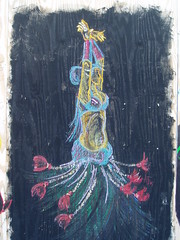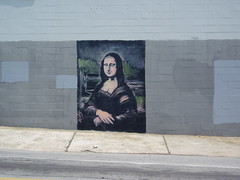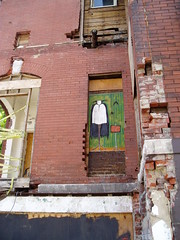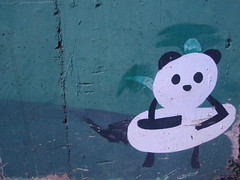The Plain Janes is the story of Jane, a pretty and popular high schooler who survives a terrorist bombing in the city. As she picks herself up off the sidewalk, she finds a single dandelion and a Polish art student's sketchbook with "Art Saves" printed on the cover. Jane decides that if these tiny, fragile things can survive, so can she, and she takes "art saves" as her new mantra when her frightened parents uproot her to the suburbs where she can be safe. High school in the suburbs is, as high school everywhere tends to be, soul crushing but on her very first day Jane has the chance to befriend the cool cheerleader types and become again the popular girl she once was, and she decides not to. Instead, she decides to sit with three outcasts, Jane, Jayne, and Polly Jane, and together they are the Plain Janes.
Now in a clique of her own making, Jane decides that art can save them all. It can save them from boredom, from apathy, and from the way that high school can marginalize some people and leave them on the outside. Joined by James, the only member of Buzz Aldrin High's Queer Club, they become P.L.A.I.N., People Loving Art In Neighborhoods, and they become guerrilla artists. They knit hats to put on all of the city's fire hydrants in winter, and build pyramids out of paving stones in construction sites. They wrap newspaper boxes and mail boxes up like presents, and cover the lawn of the police station with gnomes. The authorities consider it graffiti, disruptive acts of vandalism, but P.L.A.I.N. has a mission to celebrate art in small ways and bring joy to the masses, and people begin to follow them. There are chalk drawings on the sidewalks and flash mob singalongs and exploding balloons filled with glitter, and in the end, art saves the Plain Janes. Art gives them self confidence, and purpose, and lifts them up from the people they were so that they become the people they want to be.
This isn't an entry about how I moved to Tennessee and became a whole other person instead of continuing down the same path I'd been on for years in Albany. Sorry if it sounded like that for a minute. Instead, this is an entry about art, random art, beautiful art left by people for others to enjoy, and how art saves. It didn't really save me from anything, but it changed the way I look at the world around me. I was trying to explain this to my friend Dabs a week or so ago, and we both kind of laughed it off, but I meant it. In looking at the advertisements and vandalism and the basic colors of the world around me with a different eye, I stopped seeing annoyances, and I started to see art. Now, every time I leave my apartment, I bring my camera with me, because I might see something wonderful. Right when I was trying very hard to stop being a pessimist and start being an optimist, this comic came along and gave me a shove in the right direction.
What is art? The art history teacher in "Art School Confidential", wonderfully played by Angelica Houston, asks the class this. She rattles off a list of the great works of the western world's artistic cannon, and is immediately met with the smug response that "everything on that list was painted by a dead white guy". That response is, of course, part of the movie's wonderfully satirical slap at the pretentiousness and self righteousness of college students everywhere, but there's also a grain of truth in there: art doesn't have to come from the "great masters" to be great. Given that, is this art?

Or this?

What about this?

This one looks like art, so is it?

Or this one?

This is the question that Katherine Watson, played by Julia Roberts, asks her art history class in "Mona Lisa Smile". Is it art? Is it any good? Betty Warren, ably played by Kirsten Dunst as a "mean girl" for the 1950's set, responds that it's not art until the right people say it is.
I've decided that I'm the right people.
This is art:

So is this:

and this:

and even this:

It's art because someone felt something when they made those things, and when I see them, I feel something, too. It may not be the same thing they felt, or even the thing they intended for me to feel, but that person and I are connected for the briefest of moments. It doesn't have to be in a museum or on a wall or in a sculpture garden or a classroom or anywhere expected. It's there, and if you want it to be, it's art, and like Jane, I believe that art saves.
4 comments:
Great post. Yes, I agree -- it's art! Often I think art is in the eye of the beholder -- like when I see art in nature (even when I can't quite capture it on film or in memory). So does that mean art can be fleeting sometimes? I suppose so. I'd like to see Art School Confidential. I'll put it on my list. Meanwhile, I completely agree: art saves.
Hey, that really was a good comic. I was doubtful when you lent it to me, but I really enjoyed the Plain Janes. And while I have never really considered graffiti "art", I have found that seeing it through your eyes when you whip out your camera, I have begun to appreciate it much more.
joel - the sincerity of this post makes me deeply uncomfortable.
respectfully,
ms. cookie
Thanks for sharing. I've enjoyed your photography on Flickr and your blog posts for several months now. I always appreciated the beauty you saw in such simple and often overlooked things, and now I can understand it a bit better. Thank you. :)
Post a Comment